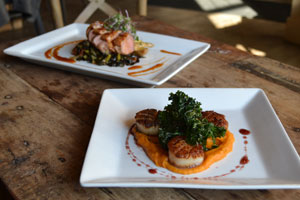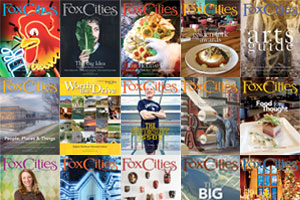Beyond Functional
Fixtures have become a driving artistic and design element
By Sean P. Johnson
These are not your parents lights and faucets.
Then again, maybe they are. But the fixtures that your parents and grandparents considered the essence of functionality–turning off the water and lighting the room–have taken on a new role as drivers of interior design.
In the battle of form versus function, form has ascended to a primary role in the artistry of interior design. It may not be the outright driver, but the look of plumbing and lighting fixtures is influencing the design of the room.
“If it’s a good design concept, then everything will feel connected” says Mariann Sykes, who, with her husband Jim, has been working on realizing the design of Givens Farm, their showcase home in Hortonville. “Not everything you like is going to fit.”
The Sykeses have created a home based on the look of a farmhouse on the French-Italian border. Lighting and plumbing fixtures play a predominant role in the theme of many of the rooms, as the Sykeses have incorporated both new and old, sometimes mixing the two, depending on the look and feel they wanted to establish for the space.
In one bathroom, for example, a dining buffet from the 1800s has been repurposed to hold a modern glass vessel sink. The light is from the Detroit area and was one of the first light fixtures converted from kerosene to electricity. The push button light switch looks as if its from the same era, but it’s as modern as can be.
Then there is the coat room.
The coat room is not finished yet, but the central element is a light fixture that played a role in the Sykeses personal history. The light is from a cabin in Michigan’s Upper Peninsula, where Mariann’s grandparents lived—one of the first wired homes when electricity came to the area.
“The room will be designed around the light,” Mariann says. “You feel like your roots are here.”
Heritage and history played a significant role in the Sykeses concept for Givens Farm, from their use of native stones in
its construction, to the early 20th century bridge on the grounds that influenced other design elements.
Many of the home’s components were recycled from other buildings and create a look and nostalgia of another place and time.
The same can also be said for the latest fixture designs to emerge from Kohler Co., the Wisconsin-based creator and manufacturer of a wide array of fixtures. If there is a company that gets how the artistry of fixtures can influence a
room, it’s Kohler.
After all, the company once released a commercial where a couple building their home challenges the architect to design a room around a faucet.
In the fall of 2013, Kohler introduced it’s Artifacts collection, a faucet and accessory line with late 19th century influences. The fixtures would look at home in both a modern building and a classic Wisconsin farmhouse, clearly an
effort to capture the nostalgia driven market.
“Like fashion, everything seems to be cyclical and come back into style,” says Chris McBrair, general manager at Watters Plumbing in Menasha, which carries a wide range of Kohler fixtures. “They are paying tribute to that earlier time and look.”
While the new Kohler products are indeed beautiful, not all local kitchen and bath designers are seeing them resonate with clients, though there seems to be some common themes in play.
McBrair says the demand for high-end fixtures depends on what stage the customer is at with their house. For those who might be building their last house or doing some wish list remodeling, there seem to be few limits. The limiting factor in most projects is price, he says.
“We see master bath suites where the powder room will have a spun glass vessel and a wall-mount faucet,” McBrair says. “Design has reached the point where you can do almost anything and it is still functional.”
Another factor driving room designs and fixture choices is simplicity, says Erin Van Ryzin, an interior designer for Kustom Kitchens and Bath Shoppe in Appleton.
“Simple, clean lines go with just about any design, whether it’s modern or from the 20s, 30s or 40s,” Van Ryzin says. “It goes with just about anything.” That simplicity, along with the retro trend, are carrying over to lighting as well, says Alexandria Hakenjos, a lighting consultant with Northtown Lighting in Appleton.
“People are into simple lines,” she says. “We are seeing a lot of retro looks with metal components that have an industrial look.”
She cited the light fixtures at Houdini’s Escape Gastropub as an example of the simple industrial look that is popular now. It sets a mood without overpowering the overall concept of the room. The Sykeses have used that same industrial concept as well.
In the kitchen, there are several lighting and plumbing fixtures that have a utilitarian look. They are simple, with clean lines that don’t distract from the dominant elements in the room. One is a sprayer attached to a sink near the ovens that resembles what you would find in a restaurant dish area.
The other is a light fixture that combines clean lines and an industrial look with the vintage spirit of recycling. It doesn’t necessarily stand out until the details are pointed out, but the Sykeses have created kitchen lighting from discarded school gymnasium lights that Jim saved from a curb just ahead of the trash truck.
“I knew we needed it,” Jim of his decision to grab the lights and the couple’s approach to finding the unique fixtures influencing the look and feel of their home. “Once you start, you can’t stop. Each piece has a dynamic that influences the space.”
—FC










Leave a Comment